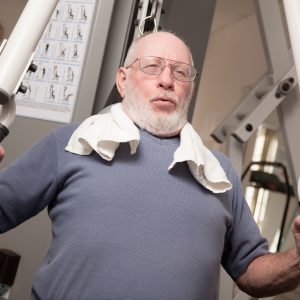Breathing- it’s something that we are continuously doing to keep us alive, but we rarely think about it as the body does it seemingly automatically. We require oxygen to function so we take a breath in to satisfy that need and then we take a breath out to expel the body of our unneeded carbon dioxide, all done without too much thought. But is breathing really that simple when it comes to exercising?
Hard working muscles require more oxygen and nutrient rich blood to function efficiently than muscles when they are at rest. Because of this and the fact there is more carbon dioxide being created which needs to be exhaled, an increase in breathing rate is required. For this reason an increase the amount of breaths you take in a minute whilst exercising is normal.
Problems can arise as often instinct when lifting something heavy can be to hold your breath, forcibly exhaling against blocked wind pipes. This is what is called the valsalva manoeuvre and it can be very dangerous and is definitely not recommended. Holding your breath increases the intra-abdominal pressure in your body. This is very dangerous as it can increase blood pressure to dangerous levels (into the 200s!), put you at higher risk for fainting and even lead to a heart attack. In order to get the most out of your strengthening exercises whilst still being safe you may need to actually think about your breathing.
How do I breathe strength training?
When breathing during strength training you should try to breath out during the exertion phase of the exercise meaning the phase that requires the most effort. Here is an example of correct breathing is when performing the squat exercise. When lowering into the squat position you should breath in as the exertion phase of the exercise is the rising from the squat position and therefore where you would breath out. It is important to note that inhaling isn’t always going to be best done in the first movement of the exercise was in the squats. An example of this is when you are doing a bicep curl. The first part of the exercise is the bending of the elbow and it is also the exertion phase so therefore where you would breathe out. The lengthening of the arm is where you would breathe in and is in this incidence the second movement.
What if I forget?
When in doubt the most important thing is to breathe! It sounds a bit silly and obvious but holding your breath to lift something heavy is very dangerous, though very common. Other benefits of effective breathing include maximising your ability to exercise and helping you exercise for longer periods.
If you have any questions please email us at contact@activeseniors.net.au or ask one of our friendly staff at our Gordon and Dee Why centres.

